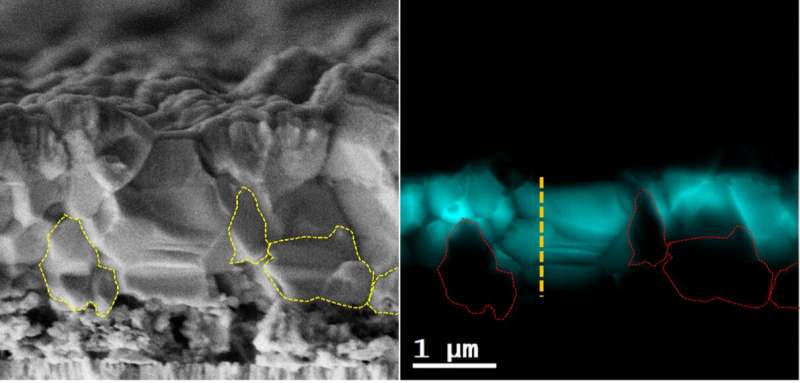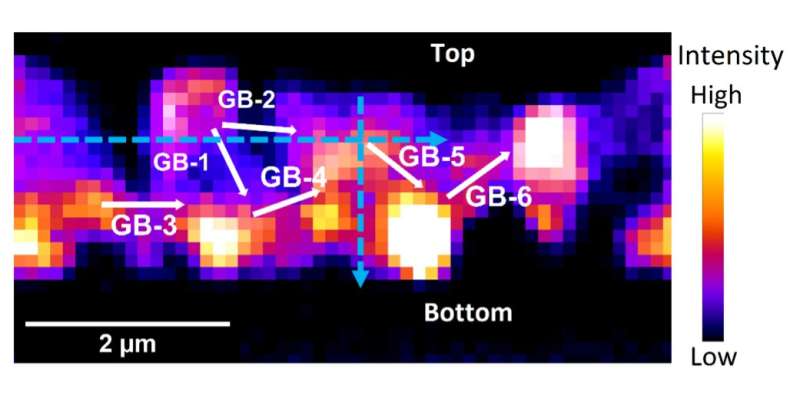August 24, 2022 feature
Microscopic carrier loss mechanisms in kesterite-based solar cells with a 12% efficiency

Kesterite Cu2ZnSn(S,Se)4 is an emerging and promising green photovoltaic material, as it is abundant on Earth, does not harm the environment, and has a stable structure, a great tunability and advantageous optoelectronic properties. Despite their qualities, solar cells based on kesterite typically have poor power conversion efficiencies, which hinder their commercialization and large-scale implementation.
Researchers at the University of New South Wales in Sydney have recently carried out a study aimed at better understanding the mechanisms that promote microscopic carrier losses in kesterite solar cells, reducing their efficiencies. Their findings, published in Nature Energy, could ultimately help to facilitate the large-scale implementation of this promising class of solar cells.
"The research community has encountered a grand challenge in improving the performance of kesterite solar cells which is associated with the unprecedented complexity of the material system as well as the carrier loss mechanisms," Jianjun Li, one of the researchers who carried out the study, told TechXplore. "It has been a long debate as to which carrier loss mechanism is dominating in current state-of-the-art kesterite solar cells."
Understanding the mechanisms underpinning carrier loss in specific types of solar cells is an essential step in their development and commercialization. The key objective of the recent work by Li and his colleagues was to identify the dominant loss mechanisms in state-of-the-art kesterite solar cells. The researchers also wanted to devise a framework that would allow them and other teams to dynamically analyze the dominant loss mechanisms in solar cells based on different emerging polycrystalline thin films, including kesterite as well as antimony chalcogenides, perovskites, and other materials.

"Despite the great promise, the full potential of kesterite is far to be tapped," Xiaojing Hao, another researcher involved in the study, told TechXplore. "The current highest efficiency is 13.6% on lab scale cells, which is much lower than their commercialized counterparts' >22% efficiency (for CIGS (CuInGa(S,Se)2) and CdTe solar cells). Nonetheless, according to theoretical predictions, its efficiency should be as high as >30%."
Several past studies have linked energy losses in kesterite-based solar cells to bulk point defects and interfacial defects. This has led to the development of different strategies to reduce these energy losses, improving the efficiency of kesterite cells to over 12%.
"An important fact that has been largely ignored in previous studies is that great microscale inhomogeneity could exist in the polycrystalline thin-film," Hao explained. "For instance, grain boundary and grain surface could have much larger recombination velocity than that in grain interiors. Therefore, understanding the carrier loss mechanisms at these microscopic regions is imperative to determine where the research efforts should be directed."
Li, Hao and their colleagues wanted to improve the understanding of kesterite solar cells, so that they can catch up to CdTe and chalcopyrite CIGSSe cells, which are now on the market. To do this, they combined a theoretical framework with three-dimensional (3D) solar cell simulations.

"Although some properties of the grain interiors and grain boundaries, such as intragrain crystallinity defects and band bending at the grain boundaries, have been investigated in the past, using high-resolution structural and electrical analysis respectively, detailed loss mechanisms in these microscopic regions, especially grain boundary recombination and grain interior carrier lifetime and their impact on the device performance, remain unknown," Hao said. "In our recent work, we unveil the microscopic carrier loss mechanisms in our record efficiency (>12%) Cu2ZnSnSe4 (CZTSe) solar cells by establishing a framework that links micro-to-macro-scale structural, electrical and photoelectrical characterizations with three-dimensional solar cell device simulations."
The simulations carried out by the researchers were based on a 3D unit cell that replicated the shape of kesterite solar cells they had created, using SEM and STEM images of the cells. The researchers experimentally obtained photo-electronic parameters of the cells, including their free carrier density, potential fluctuation, bandgap grading and statistical average SGB (non-radiative recombination velocity at the grain boundaries). All of these parameters were integrated into their simulation model.
"Intragrain electron and hole lifetimes and mobilities can be obtained by matching the experimental J–V and EQE," Hao said "In particular, the non-radiative recombination velocity at grain boundaries and grain interiors is first qualitatively compared by performing cathodoluminescence (CL) mapping on a directly cleaved cross-sectional CZTSSe device."
The researchers used different microscopic and macroscopic characterizations of solar cells they had created to estimate the carrier transport at the device's front and rear interfaces. This allowed them to determine carrier recombination mechanisms in both the grain interiors and at grain boundaries, but also to estimate the concentration and fluctuation of carriers.

In their measurements, the team found that in the region they measured all grain boundaries exhibited a pronouncedly lower CL intensity than that found in the gain interiors. This suggests that the grain boundaries have a far larger non-radiative recombination velocity than the grain interiors.
"Apparently, grain boundary recombination is dominating the carrier loss that we observed from EBIC (electron beam induced current) images," Hao said. "This is an exciting, suppressing, and yet reasonable result. It is actually the incentive for the above-mentioned overall designed framework combining the characterizations and 3D photovoltaic device simulation to attain the carrier recombination velocity at grain boundary and lifetime of grain interior and subsequent path towards beyond 20% efficiency."
Essentially, using measurements, simulations and calculations, Li, Hao and their colleagues were able to create a 3D simulated model of their device. This model helped them to unveil the primary microscale carrier mechanisms affecting the solar cells' performance.
The team showed that grain boundary recombination limits the effective carrier lifetime of bulk kesterite. They found that the associated grain boundary recombination velocity of kesterite, at a level of 104 cm s−1, is one to two orders of magnitude larger than that of CIGSSe and CdTe; while the intragrain minority carrier lifetime is estimated to be 10–30 ns and the net carrier density around 1.8 × 1015 cm−3.

"It seems that the well-recognized open-circuit voltage (VOC) losses due to bandgap fluctuation and/or electrostatic potential fluctuation are small," Hao said. "Instead, the dominating loss mechanisms of current state-of-the-art CZTSe solar cells are associated with the severe non-radiative recombination at grain boundaries. These findings mean the carrier loss mechanisms of kesterite CZTSe is more like the historic CdTe rather than the long-believed chalcopyrite (CIGS)."
The recent work by this team of researchers shows that kesterite could have a surprisingly large intragrain electron lifetime of 10-30 ns and large intragrain hole mobility of 30–50 cm2V-1s-1. These values highlight the huge potential of the material for the creation of efficient solar cells and other optoelectronic devices, including photodetectors and photocathodes for photoelectrochemical (PEC) devices.
"We showed that the bulk quality of our kesterite materials is much better than expected from the community and that the key problem of the low bandgap kesterite solar cells is the inner interfaces (grain boundaries), which is a very surprising but reasonable finding," Li said. "We now hope to find out more about the grain boundaries of kesterite materials, and to devise a proper method to cure the grain boundaries of kesterite materials as the historic grain boundary passivation of the commercialized Chalcopyrite (CIGS) and CdTe thin-film solar cells."
In the future, the findings collected by Hao, Li and their colleagues could pave the way towards the development of kesterite-based devices with efficiencies of over 20%. In addition, the model they created could be used to better understand the underpinnings of complex solar technologies based on thin films of other emerging materials.
"Based on this work, further efficiency improvement towards beyond 20% efficiency requires substantial grain boundary passivation and increase of net carrier density," Hao added. "Our next studies will be focused on understanding the defects at grain boundary of kesterites and developing grain boundary passivation strategies."
More information: Jianjun Li et al, Unveiling microscopic carrier loss mechanisms in 12% efficient Cu2ZnSnSe4 solar cells, Nature Energy (2022). DOI: 10.1038/s41560-022-01078-7
© 2022 Science X Network



















